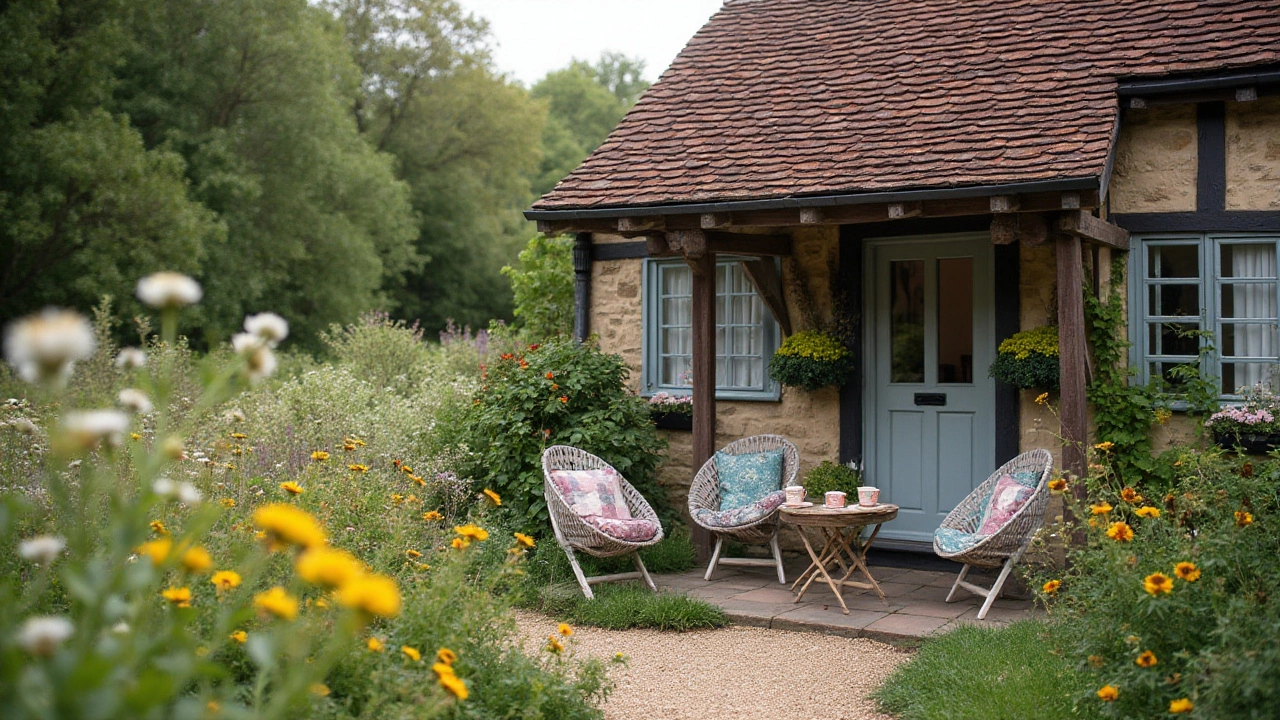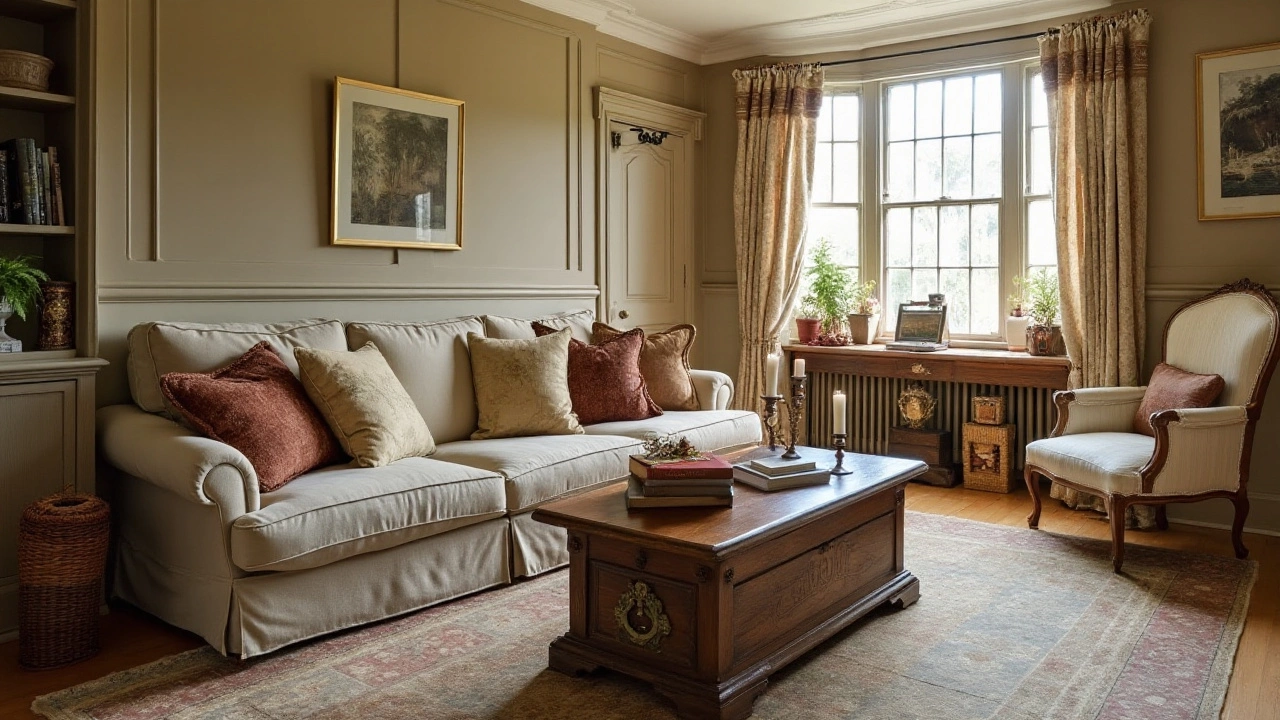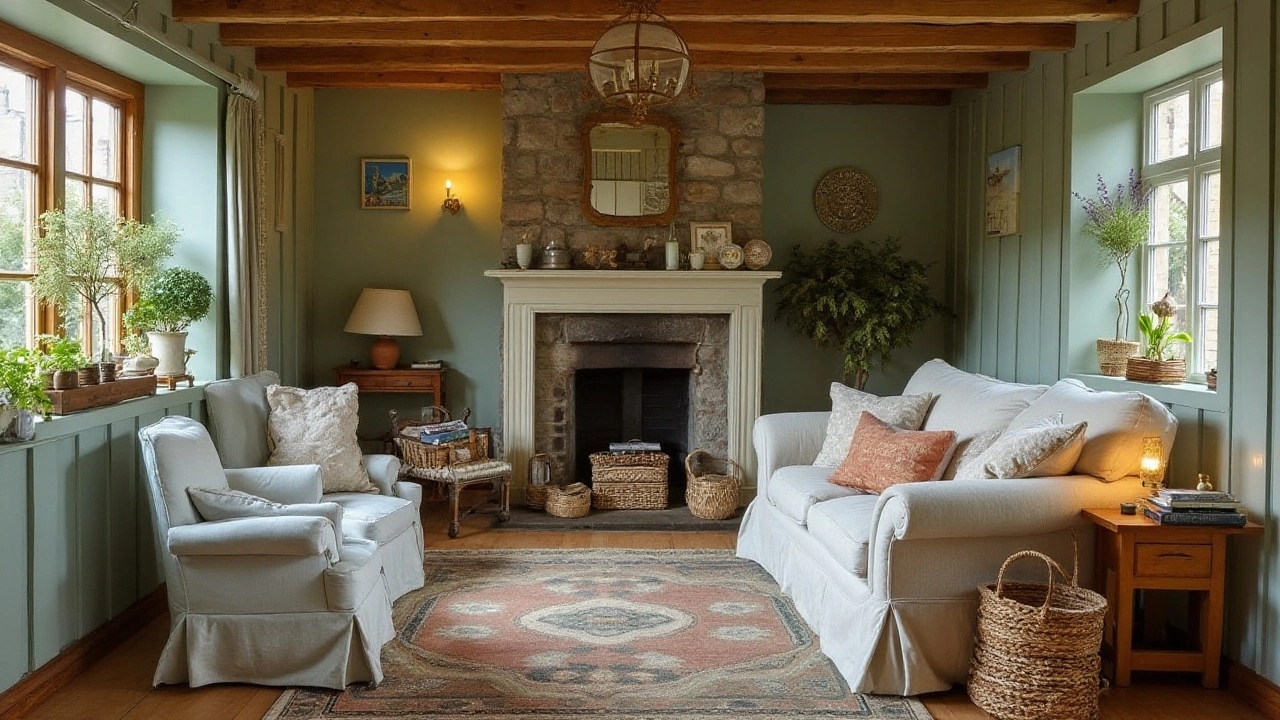The cottage style has been a beloved interior design choice for generations, offering a mix of comfort and charm that never seems to go out of fashion. As we step into 2025, this classic style is being reimagined with fresh twists, effortlessly blending the old with the new. This updated version emphasizes a balance between rustic appeal and modern functionality, making it perfect for those who cherish both nostalgia and trendiness.
Today's cottage style harmonizes natural materials and vintage elements with contemporary design principles. It's about crafting spaces that speak to our desire for warmth and simplicity while infusing unique character and depth. Whether you're redesigning a quaint countryside abode or bringing cottage vibes into a city apartment, the new cottage style offers endless possibilities to create something truly memorable.
- Understanding the New Cottage Style
- Color Palettes That Work
- Furniture and Decor Essentials
- Incorporating Nature and Textures
- Personal Touches and Eclectic Elements
Understanding the New Cottage Style
In the world of interior design, the new cottage style is capturing the imagination of homeowners who long for environments that feel both cozy and timeless. This design movement is about more than just aesthetics; it’s a lifestyle that embraces simplicity, warmth, and a connection with nature. At its heart, the new cottage style marries the rustic charm of traditional cottages with the sleek lines and functionality required by contemporary living. This trend is not about replicating the past but reinterpreting it to fit today's needs, ensuring spaces are harmonious and inviting.
A crucial aspect of the new cottage style is the integration of natural materials into the home. Think about the texture of weathered wood, the cool touch of stone, and the warmth of wool. These organic elements ground the home, creating an ambiance that feels refreshingly earthy and honest. Meanwhile, vintage elements like distressed furniture or reclaimed architectural details provide that rustic charm that is unmistakably cottage. This blend of new and old ensures that the space feels curated and storied, rather than haphazard or cluttered.
The new cottage style doesn't shy away from embracing diverse influences. It's a style that welcomes eclectic touches, whether that's a piece of Moroccan tile, an antique French chair, or a contemporary Scandinavian rug. These global elements provide layers and textures that make a home feel whimsical without losing its fundamental coziness. According to a survey by Home Design Magazine, 78% of homeowners who embraced this eclectic mix reported increased personal satisfaction and comfort in their homes.
"Your home should tell the story of who you are, and be a collection of what you love." – Nate Berkus, renowned interior designer
To achieve the new cottage style, it is essential to pay close attention to the details. Here, even the smallest elements can transform a space. Consider soft furnishings and accessories that add character like handwoven throws, vintage pottery, and botanical prints. All these items contribute to the overall picture of coziness and elegance. The key is to ensure these items speak to one another, creating a cohesive and inviting space that goes beyond mere decoration. It’s about crafting a personal sanctuary that reflects both history and hopes for the future.
Another notable trend is the use of a muted, nature-inspired color palette. Soft greens, muted blues, and soothing creams provide a neutral backdrop that allows furniture and decor to shine. These colors draw the eye towards the outdoors, effectively blurring the lines between inside and out. Paired with large windows or doors that let natural light flood in, a cottage style home feels like an extension of the landscape itself, inviting tranquility and peace. This connection to nature isn’t just aesthetic; studies show that exposure to natural light and colors can enhance mood and reduce stress levels, making the new cottage style not only beautiful but beneficial for well-being.
Adopting the new cottage style doesn't mean that modern conveniences must be sacrificed. On the contrary, technology and comfort can coexist with traditional elements. Modern appliances can be seamlessly integrated into farmhouse kitchens, and smart home features can be hidden within charming nooks. The goal is to achieve a balance where new technologies enhance the lifestyle without overshadowing the enduring allure of cottage living.
Color Palettes That Work
When it comes to mastering the cottage design, choosing the right color palette is essential to setting the tone and atmosphere of your space. The new cottage style leans heavily on warm, inviting hues that evoke feelings of comfort and relaxation. Earthy tones such as warm beiges, soft greens, and dusty blues serve as a canvas, creating a serene environment that feels like a true escape from the hustle and bustle. These colors not only bring nature indoors but also complement the rustic elements commonly found in this style.
While traditional cottage schemes often centered on pastel colors, today's trends encourage richer, more saturated hues that can make a statement. For instance, pairing a deep, forest green with lighter accents of cream and taupe can create a cozy yet sophisticated backdrop. It's about striking the right balance where bold can meet subtle without overwhelming the senses. The use of contrasting colors works beautifully, such as pairing a navy blue cabinetry with white countertop surfaces, adding a fresh and clean look to kitchens and bathrooms.
To ensure cohesion and flow throughout your home, consider the concept of color layering. Start with a dominant base color and build upon it with complementary tones and textures. For instance, when working with a neutral palette, adding hints of ochre or mustard can bring warmth and depth. Fabrics and accessories in varying shades of a central color can add interest and pull the space together effortlessly. This method not only enhances visual appeal but gives the atmosphere a polished, curated feel that's integral to the new cottage style.
"The power of color is one of the most underappreciated elements in home design. It has the ability to transform a space from ordinary to extraordinary." - Jo Heinz
Moreover, going beyond the traditional palette means embracing unexpected pops of color. Think about integrating cheerful yellows, corals, or even vibrant maroons in smaller doses. These colors can be introduced through decorative items, throw pillows, or even in artwork adorning the walls. Such accents inject energy and life into spaces, creating focal points without detracting from the overall design philosophy. The idea is to have small, delightful surprises that enrich the home’s narrative.
Additionally, textures play a crucial role in enhancing your chosen color scheme. Mixing and matching materials like woven fabrics, distressed woods, and stone can add dimension and visual interest, aligning beautifully with cottage themes. Textures allow colors to come alive, adding a tactile quality to the aesthetic. A well-draped linen throw or a woolen rug on natural wood floorboards not only complements the color scheme but also adds an extra layer of comfort synonymous with snug cottage living.

Furniture and Decor Essentials
When it comes to crafting a home that embodies the cottage design style, the selection of furniture and decor is paramount. Unlike more industrial or minimalistic trends, this style prioritizes warmth and comfort above all. Begin with well-made staple pieces that bring a sense of relaxed elegance. Think about materials—they need to tie into the natural elements emphasized in cottage aesthetics. Woods like oak, pine, and reclaimed varieties offer a rustic charm that feels timeless and inviting. Metal and glass, though often part of other modern styles, find their place here as accent materials, adding a hint of sophistication without overwhelming the simplicity that is so cherished.
A large, worn-in sofa serves as the heart of a cozy home. Ideally, it features plush cushions complemented by soft, breathable fabrics like linen or cotton. Patterned slipcovers may introduce an extra layer of comfort, signaling to guests that relaxation is welcome here. Upholstery in muted tones is often the go-to, but don’t shy away from well-coordinated, tasteful florals or checks—the subtle clash can create a vibrant yet homely feeling.
"In cottage design, every piece should tell a story or conjure a memory," notes renowned interior designer, Sarah Anderson.
Your seating arrangements might be rounded out with a mix of chairs. A wingback chair adds an element of prestige and is wonderfully practical for reading nooks, while an overstuffed armchair can serve as an ideal contrast against carved wood tables. Tables crafted from distressed wood mirror the aged authenticity that’s a core tenet of the country cottage trends. It’s about creating spaces that encourage gathering and shared experiences, whether at large farmhouse tables or intimate tea tables.
As for decor, incorporating nature through dried flowers, potted houseplants, and botanical prints can heighten the rustic charm without being overpowering. Wall decor frequently consists of personal artifacts—framed photographs, mixed with simple landscapes or still-life paintings, can inject a layer of personality that makes the space uniquely yours. If the opportunity arises, feature a collection that adds character, like antique china or artisanal pottery, ideally blending seamlessly with hand-me-down treasures.
Lighting choices also play a critical role, contributing to the mood and functionality of a cottage-style home. Lamps with fabric shades, particularly those with pleated designs, can offer ample soft lighting reminiscent of twilight hours. Candle holders, especially those in wrought iron or antique brass, serve not only a practical purpose but also build an atmosphere of intimacy. Don't neglect window treatments, either. In classic cottage interiors, windows are often adorned with lacy or embroidered textiles, adding to the quaint feel while diffusing natural light.
To summarize, selecting furniture and decor for a cottage interior is akin to embarking on a creative journey. It’s about merging craftsmanship with personal taste, ensuring each piece fulfills a purpose, whether for storytelling, function, or beauty. With the right balance of comfort, aesthetics, and sentiment, your abode can effortlessly reflect the nuances of a well-loved cottage design throughout generations.
Incorporating Nature and Textures
One of the hallmarks of the cottage design is its use of natural elements that bring the outside in. This approach not only enhances the aesthetic appeal of your home but also promotes a serene and grounded environment. To start, consider incorporating materials such as reclaimed wood, stone, and clay into your interiors. These elements echo nature's rugged beauty, lending an organic warmth to spaces that modern materials sometimes lack. For instance, a rustic wooden beam can serve as an exquisite mantel, while stone flooring provides both durability and a timeless appeal. You might even explore clay tiles, which add an earthy tone and texture to kitchens and bathrooms.
Textures play a crucial role in creating the cozy, inviting atmosphere characteristic of cozy homes. Layering different textiles is a great way to achieve this effect. Think about using chunky knit throws, soft woolen rugs, and linen cushions to bring texture into living areas. Mixing and matching these elements can create a rich tapestry of touch and visual interest without overwhelming the room. Fabrics like cotton and linen not only enhance the tactile experience but also help to regulate temperature naturally, making them practical choices for all seasons. A rustic jute rug underfoot can add another layer of comfort and texture, connecting the modern with the traditional in a seamless way.
Incorporating natural greenery is another effective method of bringing a slice of nature indoors. Houseplants like ferns, succulents, and flowering pots inject life and color into any room, filtering the air and enhancing the ambiance. Placement is key; try placing a vibrant potted plant on a windowsill or a trailing ivy over a corner shelf for that classic country cottage touch. If caring for live plants isn't feasible, explore quality silk plants that offer the look without the maintenance. Another tip: consider large terrariums with a mix of plants to function as focal points in living areas. Including nature-based imagery through art, such as landscape paintings or botanical prints, further supports this theme.
Seamlessly combining natural elements with different textures also encourages crafting a personalized narrative in your home. For the adventurous, don't shy away from eclectic mixing - vintage finds alongside modern sensibilities can yield stunning results. One might draw inspiration from global nomadic styles, perhaps incorporating handwoven textiles from Peru or ceramics from Portugal. This not only celebrates artisanal craftsmanship but also weaves a story unique to your abode. As design expert Nathan Turner once said,
"Your home should tell the story of who you are, and be a collection of what you love."This ethos is at the heart of new country cottage trends, where every piece is meaningful and every texture tells a tale.
A recent survey indicated that over 70% of homeowners prioritize eco-friendly materials in their renovation projects, emphasizing a global shift towards sustainable living. The
| Material | Eco-friendly Rating |
|---|---|
| Reclaimed Wood | 9/10 |
| Natural Stone | 8/10 |
| Bamboo | 7/10 |

Personal Touches and Eclectic Elements
In the realm of the new cottage style, the flourish of personality is as essential as the beams and bricks that form the structure. It's not just about decorating; it’s about storytelling. Every vignette, picture frame, and quirky addition whispers a narrative unique to its environment. Homeowners today are increasingly drawn to personalized spaces that break the mold of homogeneity, inviting an infusion of individuality and character. This trend emerges boldly in the form of eclectic mixes, where old heirlooms rub shoulders with newfound treasures, creating a tapestry of time and taste.
What is fascinating is how cherished personal artifacts can breathe life into cottage interiors. Consider a well-worn armchair passed down through generations, its fabric lovingly faded in places, mingling with a splashy modern throw pillow. These pieces, placed thoughtfully, not only offer comfort but also act as conversation starters. Similarly, an inherited quilt draped casually over a sleek, modern sofa introduces a layer of warmth and history. And don’t underestimate the power of a well-chosen piece of art; a painting bought during your travels can jazz up a simple wall, transporting viewers to a different world. According to interior designer and author John Loecke, "The beauty of eclectic design is that it allows one’s personal story to unfold room by room."
The art of incorporating eclectic elements lies in striking a harmonious balance between the varied objects. The magic formula often involves focusing on a cohesive color palette or theme that ties disparate objects together seamlessly. For example, if your living room leans towards earthy tones, ensure that your eclectic elements—ranging from funky vintage finds to vibrant modern art—play nicely within that color spectrum. This approach avoids visual chaos, ensuring a tranquil and inviting space. An effective technique is grouping items in odd numbers, which naturally draws the eye and creates a visually appealing arrangement.
Creating Cozy Corners
Designing intimate nooks within your cottage adds another layer of coziness, inviting you to linger a little longer. Imagine a small reading corner with a stack of books you've collected over the years. Add a vintage lamp for soft, warm lighting, and suddenly, it becomes a personal retreat where you can unwind. Incorporating different textures, like a plush rug or a knitted throw, adds to the sensory experience, enhancing the spot’s appeal. Not only does it offer a refuge from the hustle and bustle of daily life, but it also serves as a visual delight.
Cultivating Eclectic Art Displays
Art is another arena where personal tastes can shine. Instead of adhering to strict symmetry, let spontaneity reign. A gallery wall showcasing a mix of old family portraits, contemporary prints, and personal photos offers a delightful journey across time and place. Consider experimenting with the frames themselves; an amalgam of various styles and periods can bring a fascinating depth to your display. The key is to embrace imperfections and asymmetry, as they inject an organic vibrancy into the space, making it feel lived-in and loved.
